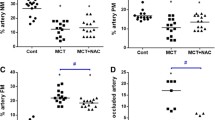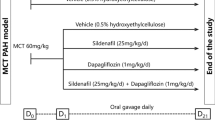Abstract
Pulmonary hypertension (PH) is a morbid complication of cardiopulmonary as well as several systemic diseases in humans. It is rapidly progressive and fatal if left untreated. In the present study, we investigated the effect of PPARα agonist fenofibrate (FF) on monocrotaline (MCT)-induced PH in rats. FF, because of its pleiotropic property, could be helpful in reducing inflammation, oxidative stress, and reactive oxygen species. On day 1, MCT (50 mg/kg, s.c.) was given to all the rats in MCT, sildenafil, and FF group except normal control rats. After 3 days of giving MCT, sildenafil (175 µg/kg, orally) and FF (120 mg/kg, orally) were given for 25 days. Echocardiography, hemodynamic parameters, fulton’s index, histopathology, oxidative stress parameters, inflammatory markers, Bcl2/Bax gene expression ratio in the right ventricle, and protein expression for NOX-1 in lungs were studied in all the groups. FF has shown to prevent decrease in ratio of pulmonary artery acceleration time to ejection time, increase in ratio of right ventricular outflow tract dimension to aortic outflow dimension, rise in right ventricular systolic pressure, right ventricular hypertrophy, increase in the percentage medial wall thickness (%MWT), increase in oxidative stress and inflammation, increase in NADPH oxidase-1 (NOX-1) expression, and decrease in mRNA expression of Bcl2/Bax ratio caused by MCT. To conclude, FF prevented MCT-induced PH in rats by various mechanisms. It might be helpful in preventing PH in patients who are likely to develop PH.


Similar content being viewed by others
References
Archer SL, Weir EK, Wilkins MR (2010) Basic science of pulmonary arterial hypertension for clinicians: new concepts and experimental therapies. Circulation 121:2045–2066. https://doi.org/10.1161/CIRCULATIONAHA.108.847707
Hui-li G (2011) The management of acute pulmonary arterial hypertension. Cardiovasc Ther 29:153–175. https://doi.org/10.1111/j.1755-5922.2009.00095.x
Pepke-Zaba J, Gilbert C, Collings L, Brown MCJ (2008) Sildenafil improves health-related quality of life in patients with pulmonary arterial hypertension. Chest 133:183–189. https://doi.org/10.1378/chest.07-0592
Sitbon O, Humbert M, Nunes H et al (2002) Long-term intravenous epoprostenol infusion in primary pulmonary hypertension: prognostic factors and survival. J Am Coll Cardiol 40:780–788
Oudiz RJ, Galiè N, Olschewski H et al (2009) Long-term ambrisentan therapy for the treatment of pulmonary arterial hypertension. J Am Coll Cardiol 54:1971–1981. https://doi.org/10.1016/j.jacc.2009.07.033
Grimminger F, Weimann G, Frey R et al (2009) First acute haemodynamic study of soluble guanylate cyclase stimulator riociguat in pulmonary hypertension. Eur Respir J 33:785–792. https://doi.org/10.1183/09031936.00039808
Maron BA, Choudhary G, Khan UA et al (2013) Clinical profile and underdiagnosis of pulmonary hypertension in US veteran patients. Circ Heart Fail 6:906–912. https://doi.org/10.1161/CIRCHEARTFAILURE.112.000091
Deaño RC, Glassner-Kolmin C, Rubenfire M et al (2013) Referral of patients with pulmonary hypertension diagnoses to tertiary pulmonary hypertension centers: the multicenter RePHerral study. JAMA Intern Med 173:887–893. https://doi.org/10.1001/jamainternmed.2013.319
Farber HW, Miller DP, Poms AD et al (2015) Five-year outcomes of patients enrolled in the REVEAL Registry. Chest 148:1043–1054. https://doi.org/10.1378/chest.15-0300
Frid MG, Brunetti JA, Burke DL et al (2006) Hypoxia-induced pulmonary vascular remodeling requires recruitment of circulating mesenchymal precursors of a monocyte/macrophage lineage. Am J Pathol 168:659–669. https://doi.org/10.2353/ajpath.2006.050599
Humbert M, Monti G, Brenot F et al (1995) Increased interleukin-1 and interleukin-6 serum concentrations in severe primary pulmonary hypertension. Am J Respir Crit Care Med 151:1628–1631. https://doi.org/10.1164/ajrccm.151.5.7735624
Itoh T, Nagaya N, Ishibashi-Ueda H et al (2006) Increased plasma monocyte chemoattractant protein-1 level in idiopathic pulmonary arterial hypertension. Respirol Carlton Vic 11:158–163. https://doi.org/10.1111/j.1440-1843.2006.00821.x
Dorfmüller P, Perros F, Balabanian K, Humbert M (2003) Inflammation in pulmonary arterial hypertension. Eur Respir J 22:358–363
Cui C, Zhang H, Guo L-N et al (2016) Inhibitory effect of NBL1 on PDGF-BB-induced human PASMC proliferation through blockade of PDGFβ-p38MAPK pathway. Biosci Rep. https://doi.org/10.1042/BSR20160199
Li Q, Mao M, Qiu Y et al (2016) Key role of ROS in the process of 15-lipoxygenase/15-hydroxyeicosatetraenoiccid-induced pulmonary vascular remodeling in hypoxia pulmonary hypertension. PLoS ONE 11:e0149164. https://doi.org/10.1371/journal.pone.0149164
Lu J, Shimpo H, Shimamoto A et al (2004) Specific inhibition of p38 mitogen-activated protein kinase with FR167653 attenuates vascular proliferation in monocrotaline-induced pulmonary hypertension in rats. J Thorac Cardiovasc Surg 128:850–859. https://doi.org/10.1016/j.jtcvs.2004.03.003
Won TW (2013) Fenofibrate, a peroxisome proliferator-activated receptor α-agonist, blocks lipopolysaccharide-induced inflammatory pathways in mouse liver. Korean J Hepato-Biliary-Pancreat Surg 17:89–108. https://doi.org/10.14701/kjhbps.2013.17.3.89
Tedgui A, Mallat Z (2001) Anti-inflammatory mechanisms in the vascular wall. Circ Res 88:877–887
Berger J, Moller DE (2000) The mechanisms of action of PPARs. Annu Rev Med 53:409–435
Straus DS, Glass CK (2007) Anti-inflammatory actions of PPAR ligands: new insights on cellular and molecular mechanisms. Trends Immunol 28:551–558
Delerive P, De Bosscher K, Besnard S et al (1999) Peroxisome proliferator-activated receptor alpha negatively regulates the vascular inflammatory gene response by negative cross-talk with transcription factors NF-kappaB and AP-1. J Biol Chem 274:32048–32054
Balakumar P, Rohilla A, Mahadevan N (2011) Pleiotropic actions of fenofibrate on the heart. Pharmacol Res 63:8–12. https://doi.org/10.1016/j.phrs.2010.11.002
Iglarz M, Touyz RM, Amiri F et al (2003) Effect of peroxisome proliferator-activated receptor-alpha and -gamma activators on vascular remodeling in endothelin-dependent hypertension. Arterioscler Thromb Vasc Biol 23:45–51
Bełtowski J, Wójcicka G, Mydlarczyk M, Jamroz A (2002) The effect of peroxisome proliferator-activated receptors alpha (PPARalpha) agonist, fenofibrate, on lipid peroxidation, total antioxidant capacity, and plasma paraoxonase 1 (PON 1) activity. J Physiol Pharmacol 53:463–475
Zuckerbraun BS, Chin BY, Wegiel B et al (2006) Carbon monoxide reverses established pulmonary hypertension. J Exp Med 203:2109–2119. https://doi.org/10.1084/jem.20052267
Paffett ML, Lucas SN, Campen MJ (2012) Resveratrol reverses monocrotaline-induced pulmonary vascular and cardiac dysfunction: a potential role for atrogin-1 in smooth muscle. Vasc Pharmacol 56:64–73. https://doi.org/10.1016/j.vph.2011.11.002
Chen XR, Besson VC, Palmier B et al (2007) Neurological recovery-promoting, anti-inflammatory, and anti-oxidative effects afforded by fenofibrate, a PPAR alpha agonist, in traumatic brain injury. J Neurotrauma 24:1119–1131. https://doi.org/10.1089/neu.2006.0216
Varghese A, Savai J, Pandita N, Gaud R (2015) In vitro modulatory effects of Terminalia arjuna, arjunic acid, arjunetin and arjungenin on CYP3A4, CYP2D6 and CYP2C9 enzyme activity in human liver microsomes. Toxicol Rep 2:806–816. https://doi.org/10.1016/j.toxrep.2015.02.008
van Albada ME, van Veghel R, Cromme-Dijkhuis AH et al (2006) Treprostinil in advanced experimental pulmonary hypertension: beneficial outcome without reversed pulmonary vascular remodeling. J Cardiovasc Pharmacol 48:249–254. https://doi.org/10.1097/01.fjc.0000248229.87510.9b
Slama M, Susic D, Varagic J et al (2003) Echocardiographic measurement of cardiac output in rats. Am J Physiol Heart Circ Physiol 284:H691–H697. https://doi.org/10.1152/ajpheart.00653.2002
Kato Y, Iwase M, Kanazawa H et al (2003) Progressive development of pulmonary hypertension leading to right ventricular hypertrophy assessed by echocardiography in rats. Exp Anim 52:285–294
Thibault HB, Kurtz B, Raher MJ et al (2010) Noninvasive assessment of murine pulmonary arterial pressure: validation and application to models of pulmonary hypertension. Circ Cardiovasc Imaging 3:157–163. https://doi.org/10.1161/CIRCIMAGING.109.887109
Jones JE, Mendes L, Rudd MA et al (2002) Serial noninvasive assessment of progressive pulmonary hypertension in a rat model. Am J Physiol Heart Circ Physiol 283:H364–H371. https://doi.org/10.1152/ajpheart.00979.2001
Girgis RE, Li D, Zhan X et al (2003) Attenuation of chronic hypoxic pulmonary hypertension by simvastatin. Am J Physiol Heart Circ Physiol 285:H938–H945. https://doi.org/10.1152/ajpheart.01097.2002
Brunner F, Wölkart G, Haleen S (2002) Defective intracellular calcium handling in monocrotaline-induced right ventricular hypertrophy: protective effect of long-term endothelin-A receptor blockade with 2-benzo[1,3]dioxol-5-yl-3-benzyl-4-(4-methoxy-phenyl-)- 4-oxobut-2-enoate-sodium (PD 155080). J Pharmacol Exp Ther 300:442–449
Falcão-Pires I, Gonçalves N, Henriques-Coelho T et al (2009) Apelin decreases myocardial injury and improves right ventricular function in monocrotaline-induced pulmonary hypertension. Am J Physiol Heart Circ Physiol 296:H2007–H2014. https://doi.org/10.1152/ajpheart.00089.2009
Poels EM, Bitsch N, Slenter JM et al (2014) Supplementing exposure to hypoxia with a copper depleted diet does not exacerbate right ventricular remodeling in mice. PLoS ONE 9:e92983. https://doi.org/10.1371/journal.pone.0092983
Kay JM, Keane PM, Suyama KL, Gauthier D (1982) Angiotensin converting enzyme activity and evolution of pulmonary vascular disease in rats with monocrotaline pulmonary hypertension. Thorax 37:88–96
Ito T, Okada T, Miyashita H et al (2007) Interleukin-10 expression mediated by an adeno-associated virus vector prevents monocrotaline-induced pulmonary arterial hypertension in rats. Circ Res 101:734–741. https://doi.org/10.1161/CIRCRESAHA.107.153023
Prié S, Leung TK, Cernacek P et al (1997) The orally active ET(A) receptor antagonist (+)-(S)-2-(4,6-dimethoxy-pyrimidin-2-yloxy)-3-methoxy-3,3-diphenyl-propionic acid (LU 135252) prevents the development of pulmonary hypertension and endothelial metabolic dysfunction in monocrotaline-treated rats. J Pharmacol Exp Ther 282:1312–1318
Ohkawa H, Ohishi N, Yagi K (1979) Assay for lipid peroxides in animal tissues by thiobarbituric acid reaction. Anal Biochem 95:351–358
Banerjee SK, Wang DW, Alzamora R et al (2010) SGLT1, a novel cardiac glucose transporter, mediates increased glucose uptake in PRKAG2 cardiomyopathy. J Mol Cell Cardiol 49:683–692. https://doi.org/10.1016/j.yjmcc.2010.06.003
Bhat L, Hawkinson J, Cantillon M et al (2017) RP5063, a novel, multimodal, serotonin receptor modulator, prevents monocrotaline-induced pulmonary arterial hypertension in rats. Eur J Pharmacol 810:92–99. https://doi.org/10.1016/j.ejphar.2017.05.048
Jeffery TK, Wanstall JC (2001) Pulmonary vascular remodeling: a target for therapeutic intervention in pulmonary hypertension. Pharmacol Ther 92:1–20
Casserly B, Klinger JR (2009) Brain natriuretic peptide in pulmonary arterial hypertension: biomarker and potential therapeutic agent. Drug Des Devel Ther 3:269–287
Jung C, Grün K, Betge S et al (2017) Arginase inhibition reverses monocrotaline-induced pulmonary hypertension. Int J Mol Sci. https://doi.org/10.3390/ijms18081609
Omae T, Nagaoka T, Tanano I et al (2012) Fenofibrate, an anti-dyslipidemia drug, elicits the dilation of isolated porcine retinal arterioles: role of nitric oxide and AMP-activated protein kinase. Invest Ophthalmol Vis Sci 53:2880–2886. https://doi.org/10.1167/iovs.11-8841
Milger K, Felix JF, Voswinckel R et al (2015) Sildenafil versus nitric oxide for acute vasodilator testing in pulmonary arterial hypertension. Pulm Circ 5:305–312. https://doi.org/10.1086/680355
Meghwani H, Prabhakar P, Mohammed SA et al (2017) Beneficial effects of aqueous extract of stem bark of Terminalia arjuna (Roxb.). An ayurvedic drug in experimental pulmonary hypertension. J Ethnopharmacol 197:184–194. https://doi.org/10.1016/j.jep.2016.07.029
Konior A, Schramm A, Czesnikiewicz-Guzik M, Guzik TJ (2014) NADPH oxidases in vascular pathology. Antioxid Redox Signal 20:2794–2814. https://doi.org/10.1089/ars.2013.5607
Wu F, Hao Y, Yang J et al (2017) Protective effects of aloperine on monocrotaline-induced pulmonary hypertension in rats. Biomed Pharmacother 89:632–641. https://doi.org/10.1016/j.biopha.2017.02.033
Veit F, Pak O, Egemnazarov B et al (2013) Function of NADPH oxidase 1 in pulmonary arterial smooth muscle cells after monocrotaline-induced pulmonary vascular remodeling. Antioxid Redox Signal. https://doi.org/10.1089/ars.2012.4904
Peng J-J, Liu B, Xu J-Y et al (2017) NADPH oxidase: its potential role in promotion of pulmonary arterial hypertension. Naunyn Schmiedebergs Arch Pharmacol 390:331–338. https://doi.org/10.1007/s00210-017-1359-2
Moran E, Ding L, Wang Z et al (2014) Protective and antioxidant effects of PPARα in the ischemic retina. Invest Ophthalmol Vis Sci 55:4568–4576. https://doi.org/10.1167/iovs.13-13127
García-Redondo AB, Aguado A, Briones AM, Salaices M (2016) NADPH oxidases and vascular remodeling in cardiovascular diseases. Pharmacol Res 114:110–120. https://doi.org/10.1016/j.phrs.2016.10.015
Green DE, Murphy TC, Kang BY et al (2012) Nox4 inhibitor GKT137831 attenuates hypoxia-induced pulmonary vascular cell proliferation. Am J Respir Cell Mol Biol 47:718–726. https://doi.org/10.1165/rcmb.2011-0418OC
Price LC, Wort SJ, Perros F et al (2012) Inflammation in pulmonary arterial hypertension. Chest 141:210–221. https://doi.org/10.1378/chest.11-0793
Groth A, Vrugt B, Brock M et al (2014) Inflammatory cytokines in pulmonary hypertension. Respir Res 15:47. https://doi.org/10.1186/1465-9921-15-47
Kasama T, Maeoka A, Oguro N (2016) Clinical Features of Neuropsychiatric Syndromes in Systemic Lupus Erythematosus and Other Connective Tissue Diseases. Clin Med Insights Arthritis Musculoskelet Disord 9:1–8. https://doi.org/10.4137/CMAMD.S37477
Almodovar S, Hsue PY, Morelli J et al (2011) Pathogenesis of HIV-associated pulmonary hypertension: potential role of HIV-1 Nef. Proc Am Thorac Soc 8:308–312. https://doi.org/10.1513/pats.201006-046WR
Korsholm K, Andersen A, Kirkfeldt RE et al (2015) Survival in an incident cohort of patients with pulmonary arterial hypertension in Denmark. Pulm Circ 5:364–369. https://doi.org/10.1086/681270
Wang X, Wang Y, Rong S et al (2014) Hepatocyte growth factor improves right ventricular remodeling in pulmonary arterial hypertensive rats via decreasing neurohormonal activation and inhibiting apoptosis. Chin Med J 127:1924–1930
Osada M, Sakai T, Kuroyanagi K et al (2014) Treatment of experimental autoimmune uveoretinitis with peroxisome proliferator-activated receptor α agonist fenofibrate. Mol Vis 20:1518–1526
Acknowledgements
We are grateful to the Indian Council of Medical Research (ICMR), New Delhi, India, for providing financial support to carry out this research work.
Author information
Authors and Affiliations
Corresponding author
Ethics declarations
Conflict of interest
The authors declare that they have no competing interest.
Rights and permissions
About this article
Cite this article
Galhotra, P., Prabhakar, P., Meghwani, H. et al. Beneficial effects of fenofibrate in pulmonary hypertension in rats. Mol Cell Biochem 449, 185–194 (2018). https://doi.org/10.1007/s11010-018-3355-3
Received:
Accepted:
Published:
Issue Date:
DOI: https://doi.org/10.1007/s11010-018-3355-3




